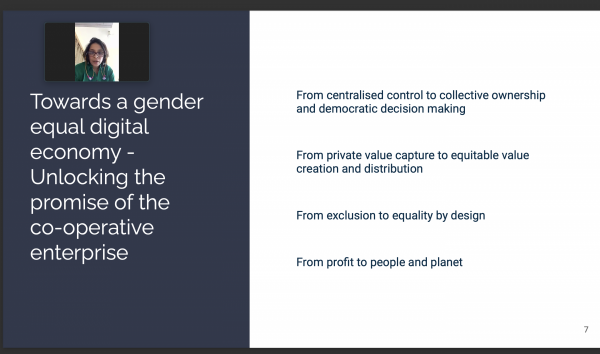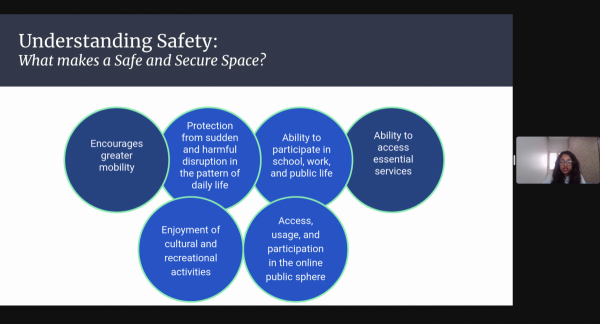
The ICA-AP Committee on Women organized a virtual lecture to commemorate the International Women’s Day (IWD) on March 7, 2023. The theme of the lecture was, “DigitALL: Innovation and Technology for Gender Equality.”
This was in line with the IWD theme and priority theme for the 67th Session of the Commission on the Status of Women (CSW-67) by the United Nations (UN), “Innovation and technological change, and education in the digital age for achieving gender equality and the empowerment of all women and girls.”
Committee Chairperson, Ms. Chitose Arai, in her opening remarks, noted the relevance of the theme of this year’s IWD. She said “when women are empowered – family as whole benefits; and it helps society to be inclusive and equitable. Cooperatives can help accelerate the digital empowerment of women. ” Bridging the digital gender divide is important and cooperatives are taking measures to adopt technology, innovation and digital inclusion.
The lecture was split into two parts. The first part focused on understanding “What do we mean by digital inclusion for women in cooperative business?” was addressed by Ms. Anuradha Ganapathy, Research Associate, IT for Change. The second part “How do we protect women's rights and safety in digital spaces?” was addressed by Ms. Malavika Rajkumar, Project Associate, IT for Change.

In her address, Ms. Ganapathy, explained how achieving digital inclusion is about correcting the multi-level power asymmetries that not only exclude women and minorities from reaping the benefits of the digital ecosystem but also shrink the space for their democratic and equitable participation, violating their rights as citizens of the state. She noted that gender inclusion is not only about addressing the inequalities related to access to digital technology but also addressing a wide spectrum of other inequalities. Digital inequality is manifested in many ways. For example, to what extent women are adopting technology, participating in decision making, and reaping the benefits of digital technology at par with men? She stressed five aspects which need attention for reducing digital gender divide – access, adoption, participation, dividends and decision making.
She added that our approach to address the digital gender divide should be rights-based. That is, when we look at digital inclusion, we should also look at how women’s rights are being protected.
While explaining digital inequality, she pointed at the inequalities that exist in the labour market. Citing references from ILO, she noted that “Only 2 in 10 workers on online platforms in low and middle-income countries are women, with significant occupational segregation in tasks and earnings between male and female workers on platforms.” This directed us to the thought that having women as a workforce in the digital spaces is not enough and the nature of their jobs should be reflected.
Ms. Ganapathy also highlighted the role of cooperatives in bridging the digital gender divide. She noted that cooperatives by their design focus on equality and not on exclusion. They focus on people and the planet over profit. She shared a techno-institutional blueprint for cooperatives. This blueprint focussed on four aspects: 1) center women’s voices which means having consultations with women and having them lead social audits, etc. 2) adopt a rights-based approach with grievance redressal support, 3) prevent value capture which means having control over your data and where and how your data is used, and 4) provide connectivity and capabilities infrastructure so that the support is not limited to access but also technical and general know-how.
Ms. Rajkumar, began her session by throwing light on safety. Safety is a feeling of security and protection, which encourages greater mobility as well as protection from sudden and harmful disruptions in the pattern of daily life. Safety, she added, should be a shared responsibility and its burden should not fall upon any one individual. She spoke about the blurring lines between private and public communication spaces. The internet has fundamentally redefined interpersonal communications, offering a platform for public discussion and discourse. However, the line between the online and offline worlds has become increasingly blurry. What may be considered a public sphere in the context of a virtual interaction can be considered as a private space in another interaction. Traditionally, patriarchal cultures have relegated women to the domestic and private spheres. Public spaces were frequented more by men and there is a certain degree of entitlement over public spaces by men which is visible in many societies.
Further, even after women were allowed to participate in public spaces, they faced a considerable amount of harassment which serves to “intimidate” them, and “remind them of their place”. These gendered dynamics that govern the public and the private extend to online spaces as well. The online public sphere, an extension of offline interactions, not only replicates the offline hierarchical structures, but also provides novel and dangerous ways of inflicting harm.

In her address, Ms. Rajkumar discussed how cyberviolence is considered less serious or “less real” than offline crimes. Cyberviolence is often treated as a non-corporeal crime since the image that emerges is of mental trauma and not physical aggression. She added that research reflects that women who engage online are subject to violence regularly in many forms. This can be in the form of vocally expressing one’s opinion, being active in politics, or simply being conspicuous in public spaces. High profile women, irrespective of profession, are likely to be victims of online gender based violence. She gave examples of different types of cybercrimes specifically targeted towards women: non-consensual intimate image distribution, digital morphing, voyeurism, online sexual harassment, gender trolling, gender-based hate speech, doxing, online intimidation and threats, impersonation and identity theft.
It was noted that protecting women's rights and safety in digital spaces requires a multi-pronged approach that involves individuals, organizations, and governments.
Here are some ways to protect women's rights and safety in digital spaces:
- Raise awareness about threats and information on tools and resources that can be used to deal with threats.
- Digital literacy on how to use technology and identify threats.
- Develop safe digital platforms with features like blocking, muting, reporting, detecting abusive content and users, etc.
- Government should focus on making laws that criminalize online abuse and harassment and ensure that perpetrators are held accountable for their actions.
- Promote gender equality in the digital space by addressing underlying causes for online abuse and harassment.
ICA-AP Regional Director, Mr. Balasubramanian Iyer delivered the vote of thanks. He noted that the safety of women is a shared responsibility and this should reflect in the designs of the digital infrastructure.
This lecture was a starting point to understand what is digital inclusion for women in cooperatives and how can their rights and safety be protected in digital spaces. The committee members who attended the lecture found the presentations insightful and useful.
*/
*/
*/



